Logitech G Saitek Pro Flight Radio Panel, Professional
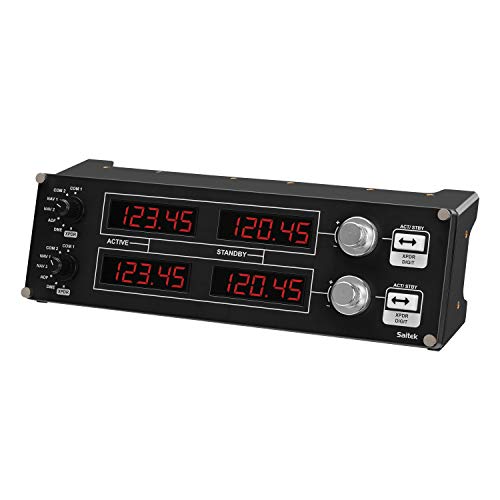
Logitech G Saitek Pro Flight Radio Panel, Professional Simulation Radio Controller, 4 Separate Led Displays, Modular and Customizable, USB, PC – Black

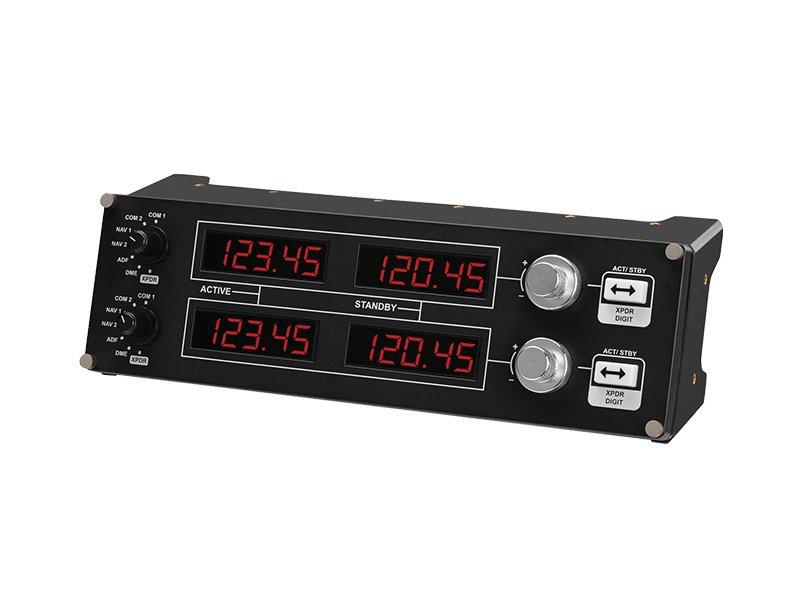 Professional Radio Controller Panel
Professional Radio Controller Panel Compact Cockpit Radio Stack
Flight Radio Panel is a stack of four LED displays with controls to set a variety of communication or navigation functions. Gone are the days of fussing with onscreen controls for COM1/2, NAV1/2, DME, ADF, and XPDR functions. Each display works in real-time with FSX, X-Plane, and Prepar3D. One or more Radio Panels easily integrates into the Flight Simulator Cockpit or your home setup.

Control adjustments in real-time
Take control. Make real-time, accurate, incremental changes within the sim or on the Radio Panel. Change frequencies on the Panel and the sim will automatically and immediately reflect your selection.

Fully customizable for all flying conditions
Modular and interchangeable, Logitech G flight panels can be stacked or side-by-side. Mounting brackets make it a snap to arrange your cockpit in a configuration only limited by your imagination.

Simple Installation
Your panel works with Windows 7, 8.1 and 10 and is compatible with your favorite flight simulation software for PCs including FSX – Flight Simulator X, X-Plane 11, X-Plane 10, and Prepar3D 2.2.
 Works with Flight Sim Software
Works with Flight Sim SoftwareIntegrates with popular flight software such as FSX-Slight Simulator and X-Plane 10
” data-position=”triggerHorizontal” />Twin Frequency DialsMake fast, precise adjustments with incremental frequencies displayed at the turn of a dial
” data-position=”triggerHorizontal” />ExpandableAdd more Logitech G radio and instrument panels to create a realistic, customized cockpit
” data-position=”triggerHorizontal” />
With Logitech G’s Pro Flight Yoke System, you can easily add Rudder Pedals and a full range of Switch, Navigation and Instrument Panels to create your perfect flight sim cockpit.

Flight Yoke System
Add precise control of multi-engine aircraft with our pro-grade yoke and throttle quadrant that feels like the real thing.

Flight Multi Panels
Get on board with this full autopilot controller with fingertip controls and an LED display that works in real-time with major flight sim software.

Flight Switch Panel
Control your landing gear and lights, engine power and other important aircraft functions, all from one compact unit.

Flight Instrument Panels
Stay on top of important flight and aircraft information in real-time with one or multiple professional simulation LCD multi-instrument display panels.

Flight Rudder Pedals
Control the rudder and toe brakes with your feet—just like the real deal.
| Weight: | 599 g |
| Dimensions: | 28.2 x 5.5 x 8.4 cm; 599 Grams |
| Brand: | Logitech G |
| Model: | 945-000011 |
| Colour: | Black |
| Batteries Included: | No |
| Manufacture: | Logitech |
| Dimensions: | 28.2 x 5.5 x 8.4 cm; 599 Grams |
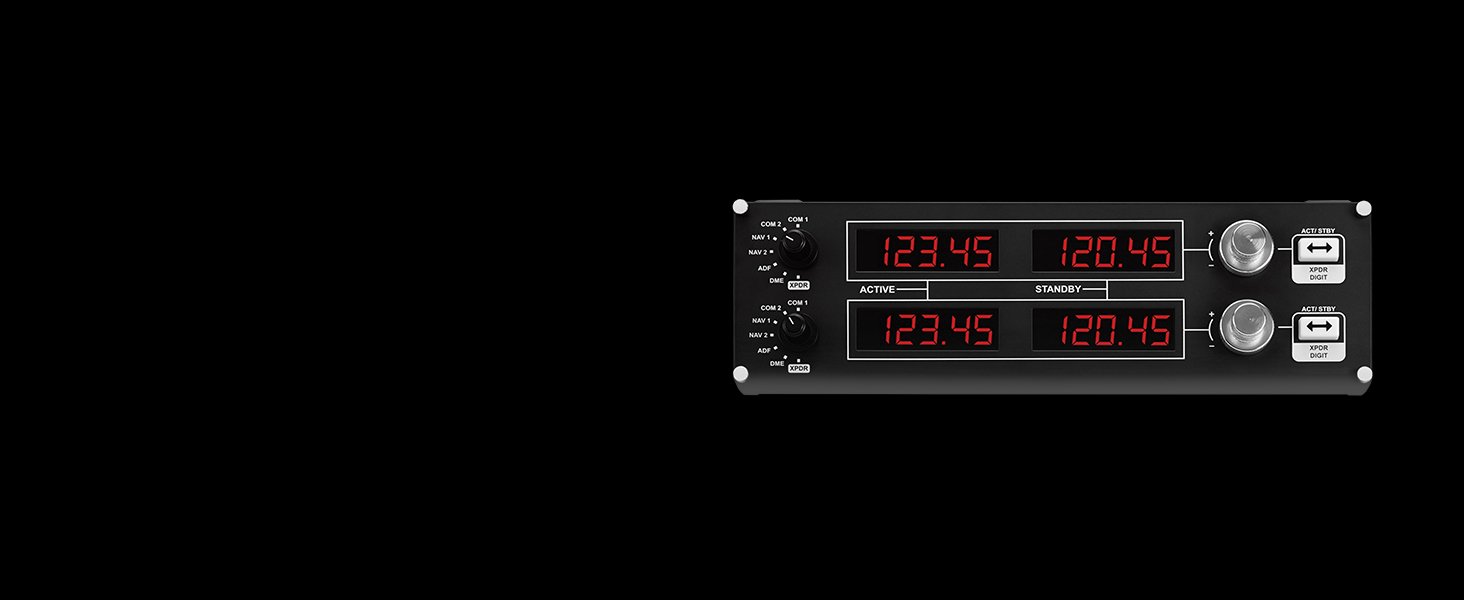
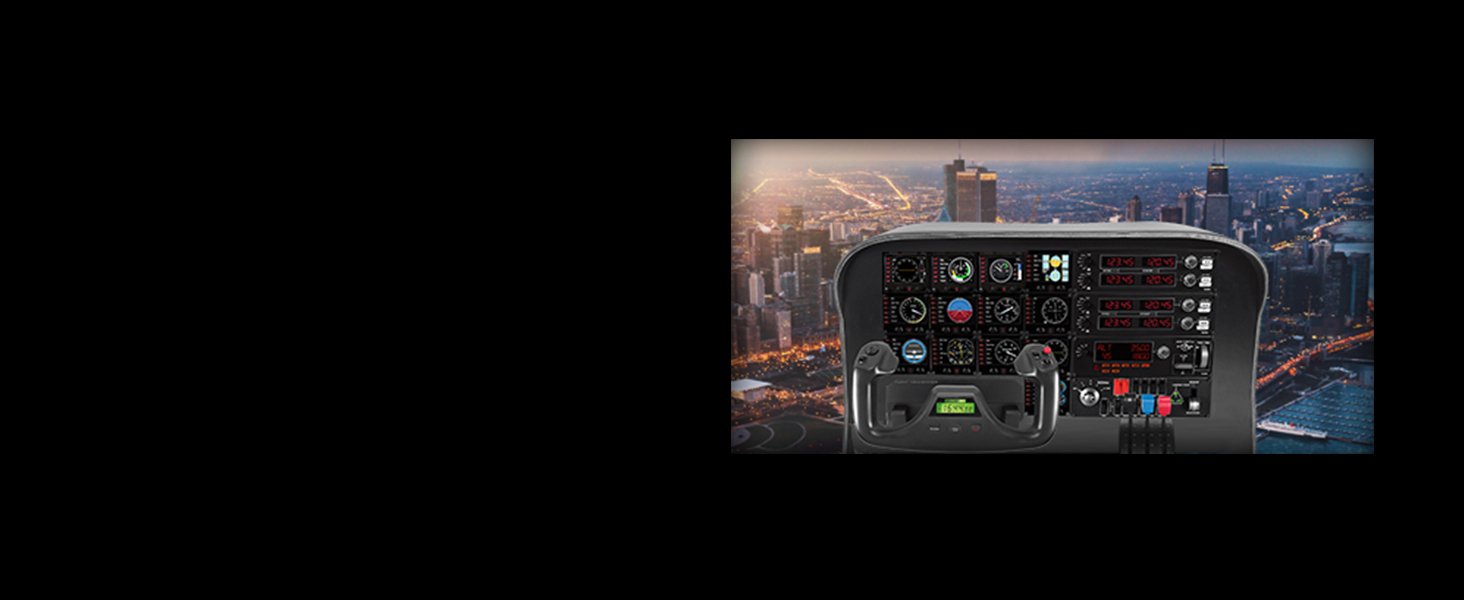
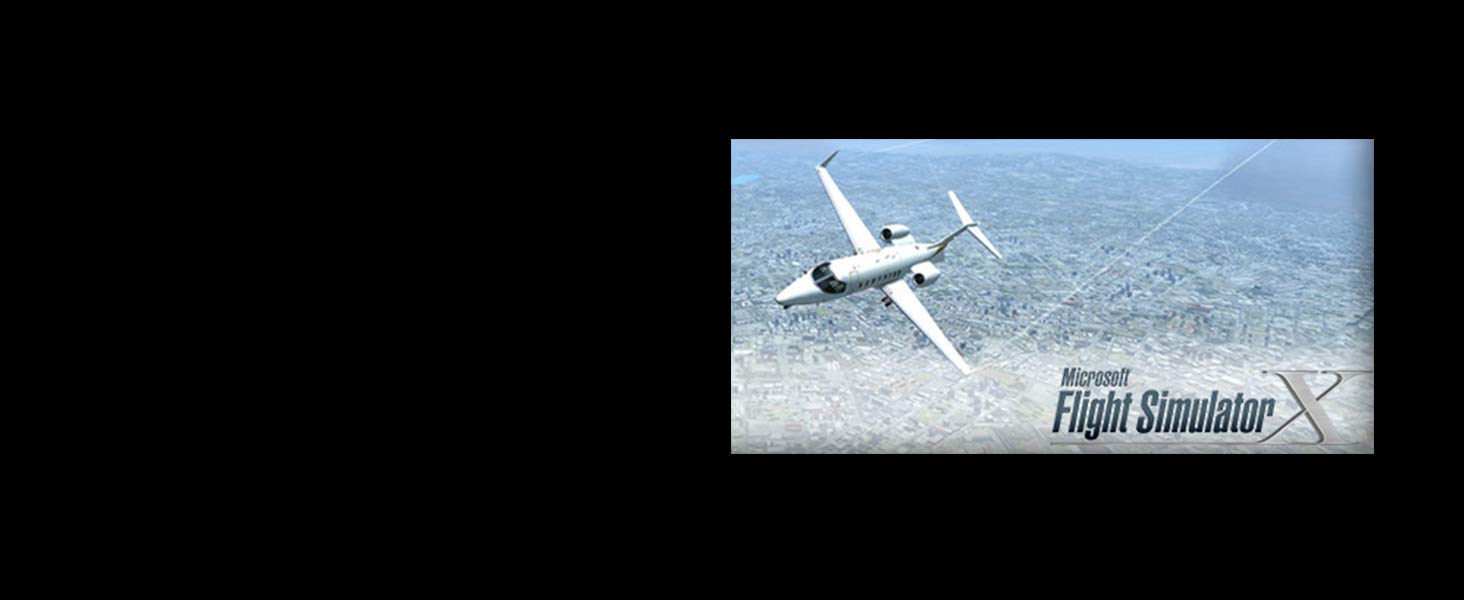
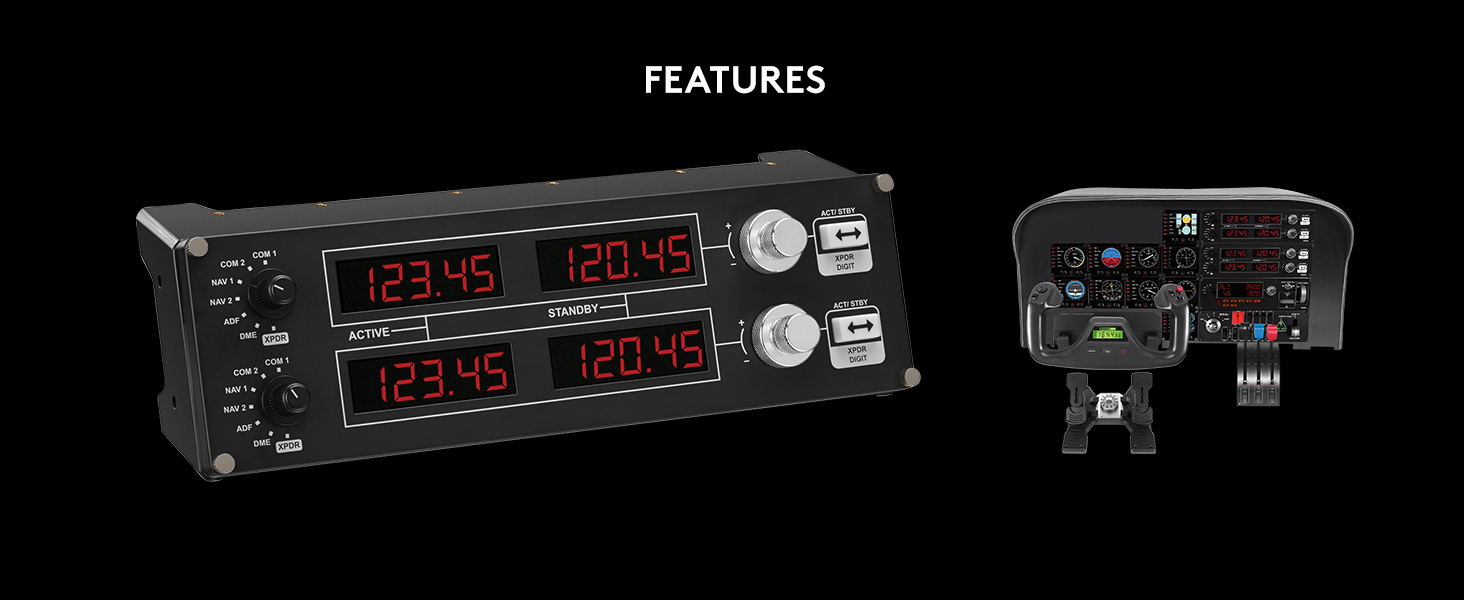
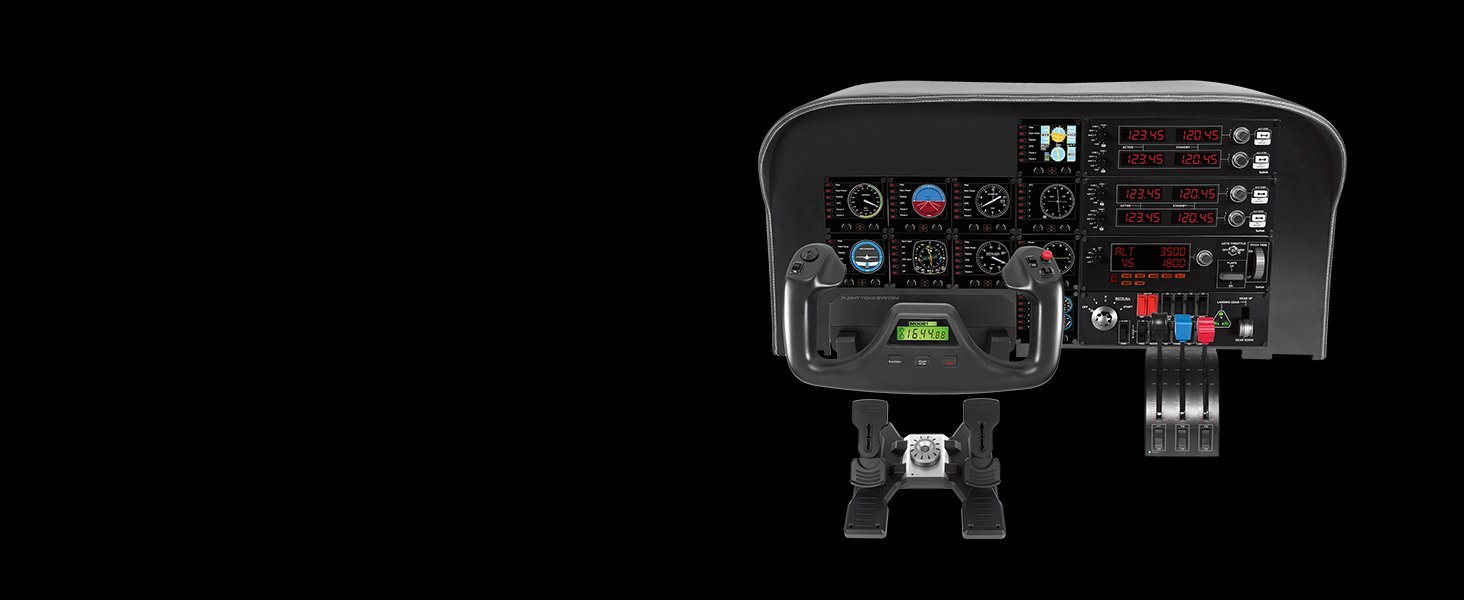
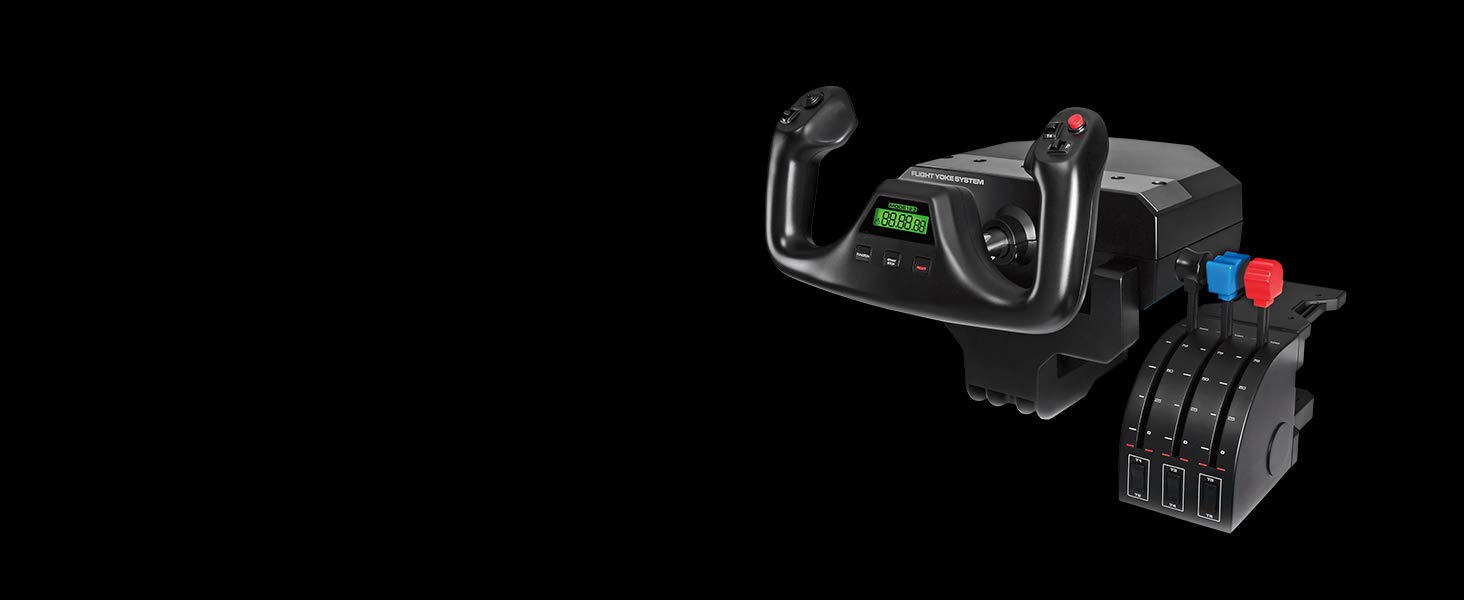
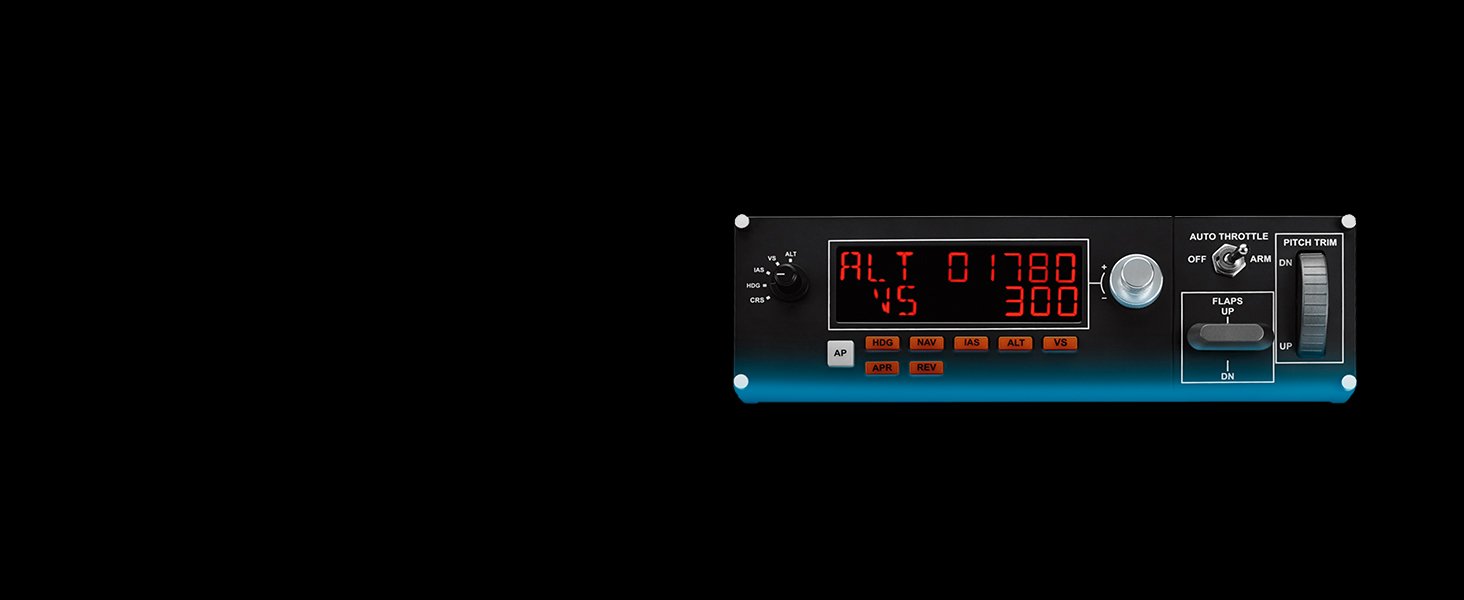


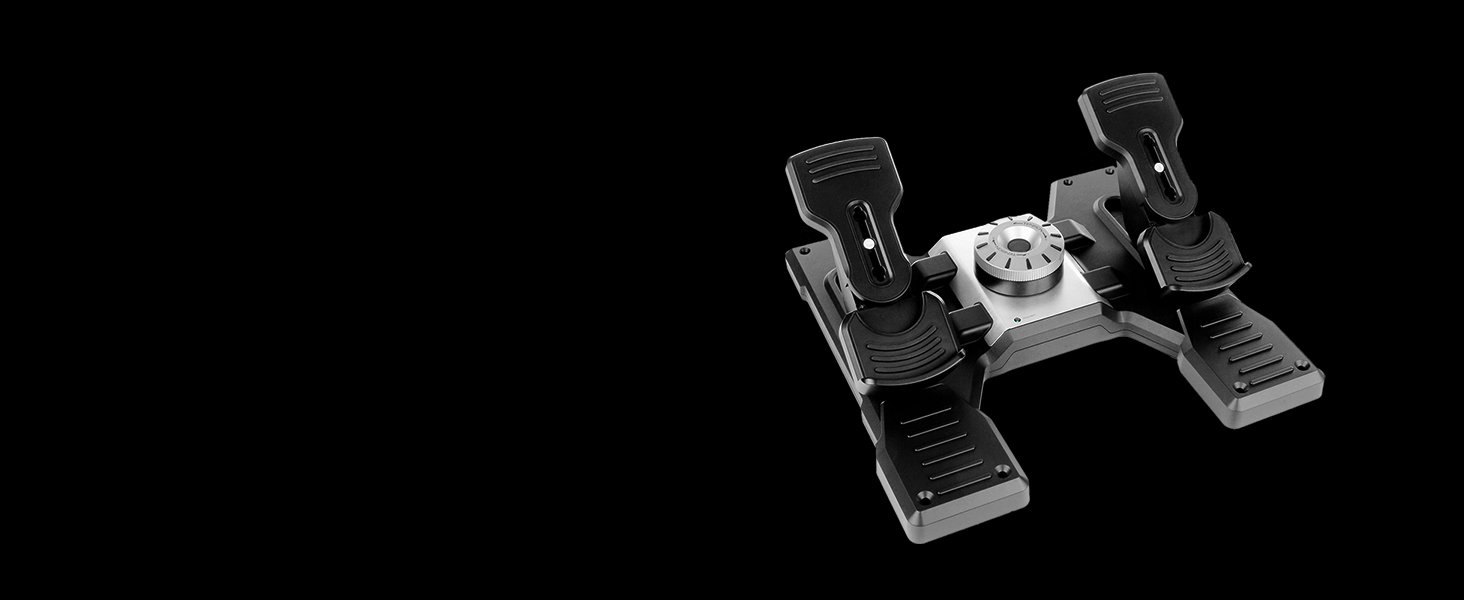
Easy to set up and comfortable to use over long periods.
Good for beginners and experienced simmers alike.
very nice looking and easy to use feels well made makes the flight simulator more realistic
Ideal if you are training for your pilot license, this was a good purchase
Definitely a good investment to your flight sim set up
I got this to go with my Thrustmaster Warthog HOTAS. Works very well indeed, with good, accurate response and full range of motion. The toe brakes are very easy to activate and the response is very good. Nothing at all to complain about. Highly recommended.
Got this for all my flight simming needs, great value price, being modular you can add more units, as I fly in vr I don’t need to see what it looks like as long as it replicates what I’m seeing in sim that’s all I need, why pay 300+ for the new fancy controllers that have been released lately just get one of these, in fact get 2.
Some items made by Saitek are listed as for the Mac operating system on Amazon – COMPLETE MISS INFORMATION ! All saitek yokes & flight panels are for Windows & Macs – it is the driver that dictates what operating system it works with. The multi panel I have just purchased cost 65 is listed as “For Macintosh” but I have got it up & running on my Widows 7 PC !!
Ive had my yoke system for a few months now. I love using it and it feels way more realistic than the previous flight sticks ive used. The power controls are good and it all works seamlessly.
However…
When getting it out the box, a plastic nib broke in the power cord to the yoke, this meant i had to make a makeshift nib so that the metal prongs could fit. Secondly, as i didnt purchase the rudder pedals, there is no way to control the rudder effectively. It needs an axis for the rudder instead of the switches that can be programmed (they dont work fluidly at all).
Lastly, after a few months, the yoke started to squeak when turning etc. I contacted logitech and they told me that this cannot be fixed and instead i need a replacement. The replacement is on its way and im excited to get flying again. Overall 8/10
They work as expected and required. Didn’t come with any instructions for me, so I can only imagine what the added parts are for. Assuming to extend mounting options.
Could be cheaper for what they are, to be honest. But they work well.
Since getting the Yoke, throttle quadrant and pedals flying has become so much more realistic and has brought GA flying to life. Besides the obvious addition of the rudder pedals adding a whole new dimension, one example is that you need noticeably more flight control deflection at lower airspeeds because of the reduced control authority. This blew my mind and now I’m finding I fly the Cessna 172 just as much as the Zibo 737-800X, although each of these flight models are as enjoyable and engaging as eachother but in different ways.
The Yoke is solid, slightly larger than a real Cessna yoke and slightly smaller than a Boeing but feels right. The movement of the Yoke is smooth and pushing/pulling for elevators has quite a large range too. The whole set is made from heavy duty plastics and you will appreciate that the first time you’re fighting with a gusty crosswind coming into land.
The throttle quadrant is good quality too although as the controls for throttle/mixture/prop are smaller they feel somehow marginally less robust than the chunky yoke – this is not a huge concern though and I’m sure they will survive for a long time.
The rudder pedals are appropriately heavy, fully adjustable from a friction point of view, and have clever optional velcro tear offs on the bottom so if you’re on carpet you won’t find the unit slipping away. (If anything, these velcro strips are TOO strong as they pulled the corner of my carpet up off the edge grippers when I moved them. Lesson learned and lifting the front of the pedals unit first solved it.
I use my office desk for work and simming and can easily get the whole system unplugged and stored within a minute or two. The twisty vice-like screws which hold the throttle and yoke to your desk feel very strong and after several weeks of going on and off show no sign of wear and tear. There are softer plastic pads on both sides of the Yoke and quadrant meaning there is almost no chance of damaging your desk.
If you’re into flight simming, this is a no brainer.
These rudder pedals are the perfect addition to any Flight Simulator setup. They are comfortable and easy to store. Setting them up is a breeze, once you have found out how to. The only place where I could find setup instructions was the Saitek blog. I would recommend following their instructions. The pedals add an extra sense of control to flying. I would advise anyone who buys these to attach some better rubber feet to avoid sliding. Overall, another amazing product.
These quadrants are designed to be modular. So this then – my second quad – has been installed into my now 2x quad simulator setup giving me individual control over the throttles, prop pitches and mixtures of my favourite twin engine aircraft.
You will need to download and install Logitechs/Saiteks free software to fully realise the potential of this product. And the level of sophistication of your simulator setup will dictate how involved the setup process will be.
A great product at a great price.
Recommended and Thanks.
Adds immersion to the simulation for a reasonable price considering the other optoins out there for the price tag it is good value if you are only using single engine aircraft. Am considering a second as I prefer twins. still way cheaper than the competitio
Fly 5 -10 minutes after you received the parcel because setup couldn’t be easier but the only the downside is that the yoke doesn’t have full 90 degree motion on left and right axis only max 45 degrees on left and right axis and throttle is great as it is really so satisfying to push up and down and it also has reverse thrust and 6 toggle buttons which is convenient as you don’t need the key board as much during flight.
So this bundle comes with a yoke and a throttle quadrant. The yoke works fine in Microsoft Flight Simulator 2020. However the throttle quadrant that comes with _this_ bundle does not. The bundled throttle comes with a PS/2 connector which is like 25 year old technology. This ps/2 plugs into the yoke, _IT_ is not seen by the OS as a separate device, therefore will not show as a game device within the control panel, device and printers sections – the yoke does. In order to get the yoke to also show the additional tab for deadzones you need to install the yoke software from their website. Do not try to install the throttle software, the next button will stay grey (as its not a USB device, but a PS/2), this is by design.
In Microsoft Flight simulator 2020, no matter what you try to do, the levers do not move properly they do not move to start, then at 50% jump to 100%. There is no fix for this at this time. (Forums are not helped as you can buy a stand alone throttle quadrant which has a USB and does work, so mixed forum feedback..)
What you can do, is to buy the stand alone Throttle Quadrant which I did, the non bundled stand alone throttle has a normal USB connection, thus is seen in devices and printers, is seen a separate device in flight simulator AND works perfectly.
So buy this bundle and the stand alone throttle quadrant, still much cheaper than any other competitor, cost me 168 (118 for the bundle and 50 for the stand alone throttle).
I had to tweak the yoke roll axis set mine to 60 – takes some tweaking not too hard.
tldr
-Bundled throttle quadrant does not work in MS flight sim 2020, it comes with a PS/2 connector. Go buy the stand alone throttle quadrant which comes with a normal USB connection (that then works fine in MS flight sim 2020).
Amazing bit of kit. Doing my PPL and needed something to practice at home on rainy no-fly days. Was really worried about reviews talking about ‘Deadzone’ – however not experienced it once. It’s exactly like the real thing – which means that when the wheel goes back to the centre the plane won’t correct/recentre itself – you have to correct it just like a real plane!! This may be what other users are experiencing? Adds to the realisum and on MS flight simulator it’s just glorious!! Sets up instantly with no faffing about. The only minor gripe is throttle and mix controls you have to know where to put them on challenges – you’ll get what I mean when you try it. However that’s Microsoft – what they should do is detect you are using the throttle (which it does) and alert you to where the power should start at.
First download the complete drivers from the website before connecting, I also found that when you have multiple units make sure you download all the drivers and updates. When I finally had the perfect set up save this on your backup settings. I had one unit and you can scroll through all the screens available using the small arrow buttons, I have decided to purchase a second unit now for navigation, I use one with the multi data screen and the other for navigation aids, also great for engine management. Overall I recommend this product, please make sure though you understand the correct set up, if it does not work correctly the easiest resolve is remove the drivers and the unit, reload and start again, it will work.
Works well with other flight equipment, most others plug into flight yoke this plugs into pc usb.
You have to download a plugin to make it works and if you slightly knock or pull out the lead from usb you have to fully reset your pc and click on plug in for it to work again, bit of a pain keep resetting to do this
Setting up was a doddle even with no instructions in the pack (2 cables and 2 clamps) and the yoke and throttle unit are recognised and preconfigured in FS2020. The yoke is a bit bigger than I expected so I’m going to need to modify my desk so it fits with all the other junk that surrounds my PC. Setting off for my first few flights and the difference between the yoke and a joystick was striking. Flying seems much more realistic and a lot easier to control.
The downsides are few but do make a difference.
Firstly the yoke shaft is lightly greased but some movements are jerky. Hopefully, more use will ease the springs.
The big issue is that the calibration continually drifts and the centre point for the left/right is constantly on the move. There are a number of workarounds on the internet but my yoke is gradually drifting right and becoming increasingly twitchy to the point that it’s impossible to maintain a heading without resorting to autopilot or wrestling with the yoke. Rudder trim doesn’t seem to help.
I’d be disappointed to have to return this for a replacement so will see how things go. Logitech support on the web doesn’t seem to be working at the time of writing this review.
I really wanted a throttle quadrant to go with my TCA sidestick and this one is great. It does the job and as I fly mostly propeller planes in not to fussed with the three lever setup and if I do use airliner I just use the throttle lever on its own.
Very responsive and allows for greater immersion when you can control the Rpm, mixture and throttle independently. The levers do have a fragile feel to them so just be gentle with it.
Enter Microsoft Flight Simulator 2020. This has changed my entire perspective on flight simming and I am very much back in the fold. This time I want to really learn what I’m doing, not just hop in any old plane and fly on autopilot from Heathrow to Paris via a quick shoot under Tower Bridge. With MSFS’ often photo-realistic scenery, real VFR navigation is now possible and I am really getting to grips with correct procedure and technique.
I want to make the experience as tactile and immersive as I can afford, and naturally that starts with hardware.
I have a couple of the Saitek panelsbut the centrepiece is the Honeycomb Alpha yoke. I have pre-ordered the Bravo throttle and autopilot, but there are delays on the shipping and it looks like it could be well into 2021. So as an interim I bought the relatively inexpensive Saitek Throttle.
In use it is great for general aviation flying (I would have preferred a Vernier style throttle but they are VERY expensive!). I tend to fly the smaller Cessnas, so just having the throttle and mixture is enough, although also having the prop pitch lever may be useful if I go up to the bigger aircraft. The three rocker switches are very useful. I only use the flaps and the handbrake, but I may well change the bindings to other useful controls. I don’t need to use the interchangeavle handles, but I can see why they might prove useful.
Build quality is reasonable. It’s all plastic, but seems sturdy enough.
My only gripes are:
1. The clamping mechanism is clunky and I haven’t worked out a perfect position yet. Compared to the clamp for the Honeycomb – well, there is no comparison, in design, effectiveness or price, so perhaps that’s unfair.
2. I wish the markings on the assembly were at smaller intervals and rather than print numbers on each segment (currently limited to 0, 25, 50, 75 and 100, as in % values) I would have preferred no numbers. with thicker lines at, say, 10% intervals.
All in all, though, it’s a decent throttle and I’m glad I bought it. Looking forward to the Bravo, though . . .
Lockdown giveth and lockdown taketh away. It giveth me loads of free time to mess around on a flight simulator, but, as a freelance corporate filmmaker, it taketh away the income to pay for it all! Having said that . . .
I’ve casually used flight sims for many years, but with the release of FS2020 I decided to do things properly and actually learn what I was doing. There’s only so many times you can fly under Tower Bridge . . .
To take it seriously you absolutely need to learn about radio navigation. VFR flying is great fun, and FS2020’s stunning scenery realism makes that so much easier, but VFR isn’t always an option. When the weather closes in, or you’re flying over water, you have to turn to the navigation instruments to get where you want to go, as well as getting help from ATC.
One of the things I loathe doing is using a mouse to turn and press knobs and buttons on screen, so this radio stack was high on my list of add-ons to buy. I can already control flaps, pitch trim etc with buttons on the excellent Honeycomb Alpha yoke (and eventually I will be able to control those things plus autopilot and more with my pre-ordered Honeycomb Bravo throttle – I currently have the Saitek quadrant). I also have ignition, lights, avionics and master battery on the yoke and I’ve bought a second hand Thrustmaster rudder pedal assembly. As a first pass for a home ‘cockpit’ I think I now have covered every important base. Anything extra (eg a second or third radio stack, individual instruments, etc) will be very-nice-to-haves but with a finite budget they’re out of reach just now. Oh, the other thing I have just discovered is the Simionic G1000 simuator for the iPad, which integrates beautifully with FS2020 and also responds to changes from the Logitech radio stack, which is great.
So, the radio stack itself:
Well, it certainly looks the part! At least it does if you are flying entry level aircraft such as the Cessna 152 (which is my learning airplane of choice). Of course it isn’t identical to a genuine Bendix/King radio stack, but the general style is the same and you do feel as though you’re using a real radio (so says someone who has never used a Cessna radio stack. Real pilots may have a different view!). The mainly plastic construction seems quite sturdy and overall build quality is good. The knobs and buttons have a firm feel to them (actually, the knobs to change between COM1, COM2, NAV1 etc might be a little TOO firm, but that could be my 57 year old fingers struggling.)
The display is bright and clear, although I have read a couple of other complaints that the brightness on individual LCD bars varies across the display. Yes, that is true, but for me it didn’t spoil my enjoyment and to be honest I hadn’t noticed it until I was told!
For now I have mounted the radio on top of my Honeycomb yoke, as you can see in the picture. Fitting was easy and only took a few minutes (there are seven screws to turn with a supplied hex key). It’s great that there seems to be a standard for mounting between manufacturers. There are several mounting options and eventually, if I remain serious about all this, I might knock up an instrument panel out of plywood and install the radio to the right of the yoke. I’d also think seriously about having two additional radio stacks, so I could dedicate one to COM channels, one to NAV channels and one to the transponder. Again, finances are preventing that for now – as well as the fact that I am waiting to see what Microsoft/Asobo does about multi-monitor support (true multi-monitor support – not using NVidia Surround, which is horribly distorted).
Software installation was easy – just follow the instructions on the Logitech drivers page. You also need to install and run a special plugin that allows the stack to talk to FS2020. This must be run before starting the sim. Occasionally I get a message saying that an instance of the plugin is already running. I haven’t worked out exactly when this does and doesnt happen as it appears to be random, but it doesn’t seem to affect anything.
I have everything plugged into a cheap four port powered hub which is also on a USB extension cable – all works fine.
In use, the stack is extremely responsive to changes in the SIM and vice versa. When given instructions to change frequency or transponder code, as soon as you make the change, the option to tune the radio in the on-screen ATC panel disappears, as it recognises you have made the change manually. In fact, the only time you now need to touch the radio stack is to acknowledge ATC calls and for other non comms related activity (eg choosing an airport, requesting vectors etc). I have bound the big red button on the yoke to Radios/Option 1 (which is always the option to acknowledge ATC calls) so I don’t have to touch the keyboard so much.
So, any niggles? Not really, other than the two things I have already mentioned:
1. Now that I have been told about the LED issue I can’t unsee it! It really doesn’t have any effect on how I use the radio stack, nor my enjoyment of it, other than me noticing it every now and then.
2. I don’t know how stiff they are in the real world, but I found the channel knobs just a tad too stiff. Perhaps they really are like that in order to prevent accidentally changing channel, and if so then all good.
At time of writing I only have one ‘that would have been nice’ observation: a volume control would have been great to be able to listen to the morse code signal from beacons, as well as to turn ATC up or down in different conditions.
And that’s it. Until I have fully mastered the use of the radio I don’t really know if there are any other shortcomings or missing features. For me, as it stands, and given my current level of expertise (I’d say advanced beginner) this radio stack is almost perfect, and a fantastic addition to my growing cockpit. From the point of view of realism and immersion, it adds another layer of both. It means I am using the mouse less and not having to zoom in to the on screen instruments so much.
I haven’t tried this unit with X-Plane 11 yet, but I see no reason why it should not perform just as well.
In summary, if you’re serious about your flight simulator exerience then this is an essential purchase. I highly recommend it.
EDIT: I bought mine at 89.99 in September 2020 – I now see the price has gone up rather a lot! Between 135 and 171 plus shipping. It seems lockdown demand has outstripped availability and a few gougers are taking advantage. That’s a shame. Currys still have them at the MRP.
UPDATE October 2021:
Well, the price has settled down and they are still available at the price I bought mine for last year (89.99). I got very angry when I saw all the inflated prices!
Anyway, I was impressed enough with the radio that I bought two more (at RRP) so I now have a stack of three. One is dedicated to COM radios, one to NAV radios and the last is for ADF, DME, Transponder and a few other goodies. It really does add to the immersion and gives you a better sense of what’s needed to manage an aircraft. I’m still flying the small Cessnas. The radios and AP are all mounted in a stack on top of my Honeycomb Bravo throttle (which I eventually received in April this year). I also have the Saitek Multipanel which handles autopilot duties. These are duplicated on the Bravo, but the Saitek has a display, which I prefer.
An absolutely must-have add-on is Spad.Next – a software app that allows you to configure the Saitek devices any way you like. I have used all sorts of presets from Spad.Next to completely customise the way the radios (and other devices) work. I can display outside air temperature, QNH, distance to DME, all kinds of things you can’t do by default. Highly recommended.
My home cockpit isn’t quite there yet, but it’s slowly shaping up. I’m still happy to recommend the Logitech Saitek Radio Panel. Don’t buy it for X-Box though, as it won’t work!
Works very well and is well made for the price range. You can get a lot better but you will also have to pay a lot more. Works pretty much straight out the box on FS 2020 just goto menu to view all controls plus yoke layout.
If you currently use a stick I would highly recommend giving this a go, it definitely adds to the experience.
So the obvious thing to do was to get was a yoke and throttle set up. The Logitech system was on sale at a discounted price, so I ordered it. I even got 0.25 P off by pre – ordering !!
I have mounted mine under the desk, photos attached. The reason was that I still wanted to use the desk with the keyboard. The supplied mount is huge. Not mentioned in the instructions, which are not supplied. They have to be downloaded , are four screw holes in the base of the yoke box. These are M4.
The wooden box to contain the yoke was made from off cuts of 8 mm ply. All joints are simple butt joints , but reinforced with 3 mm dowel . All glued together with PVA.
Its being used with XPlane 11, and Orbx True Earth scenery of GB, the latest versions. Its a bit different from the Thrust Master Joystick I was using.
Still in the process of fine tuning. and assigning buttons etc. But its working fine. Its a bit more like flying a light aircraft. The so called dead spot around the central position of the yoke I have not had a problem with. I am still playing around with the response curves at the moment.
Each lever also has a switch at its lowest point, so this could be used for engaging reverses, for example, or anything you wish, really. Below each lever is a rocker switch, non latching, which again can be configured for whatever you wish, giving you nine additional switches.
Movement of the levers is smooth, with one exception. When moving in and out of the lowest point there is a noticeable jump up to the 0 point. I have read online this is due to a ball bearing that some internal structure moves over, and this can be removed if you wish, but I rather like it as it gives me a noticeable feel to it as you move in and out of that position.
A great price, for a great piece of kit, and no doubt won’t compete with the likes of a Virtual Fly TQ3/6, but then it is a tenth of the price, an the Virtual Fly comes with no buttons at all.
Outstanding!
First the good points.
– nice solid unit; quality build
– comes with a slot to bolt into – nice screws supplied
– the unit screws onto a compatible yolk that keeps everything steady
– the click buttons are very solid – quite stiff but a satisfying click.
– the twiddle buttons work fine
– very clear digital display
– options to tune NAV1 & 2, Comm1 & 2, adf, show DME, etc. On top and bottom
not so good things
– setup! Logitech drivers (via website) waste of time. Could not get this to work with FSX.
– managed to get it consistently working downloading the free SPAD tool. Only way to go (but requires FSUIPC)
other thoughts
not sure I like it mounted on the yoke. It pretty much sits in your face, so am trying it just under the FSX radio panel. The usage of it does allow me to run the GPS bigger.
Using it to tune NDB (ADF) royal pain. If you are at 900 and need to get to 300 say, that’s a lot of knob turning. Easier to use the on screen ADF. Unless I missed something….
A bit of an extravagance and in two minds whether I should have bought this!
I wish I’d made the switch earlier. This thing is fantastic. The build quality is superb. The yoke movement is slick and predictable.
There are a multitude of buttons and rocker switches which can be mapped to sim functions of your choice, so you have a lot of control over aspects of the sim without having to move your hands too far.
I purchased the package comprising of the Yoke and Throttle Quadrant.
The throttle is also well built, but the levers don’t seem so sturdy. They should do the job well enough, though.
The clamps on both are excellent. My setup means I can’t have these items clamped to my desk at all times (as I also have to use it as a desk now and then), but they’re both very easy to add and remove. The big plastic screws holding things in place don’t need to be tightened very much at all to keeps things in place, which should help with longevity.
The yoke really has transformed my sim experience. I mostly fly the default Cessna 172 and Xibo 737 , both in X-Plane 11 (on an iMac), and both of these aircraft obviously have this traditional style of yoke rather than a flight stick, so the yoke helps mimic the experience more realistically than it does with a joystick.
It’s also nice being able to hold the aircraft in a turn with one hand whilst adjusting controls with the other – not an easy trick with a joystick.
If you’ve been sitting on the fence, I’d recommend you give it a try. It really has made a world of difference to my simming – all in a positive way.
Also, it’s outstanding value for money for the Yoke and Throttle combination.
—
Update: The original item failed after a couple of months, but was promptly replaced by Amazon. The replacement unit has been working fine since then. I would still recommend this product – I assume I just had a duff initial unit.
That said, it works nicely when set up on XPlane 10 (11 arriving tomorrow) and the three rocker switches below each lever I have set up for pitch, roll, and yaw trim.
I bought the Thrustmaster rudder pedals because the Logitech ones weren’t going to be available until the end of the week, but they are really nice to use and seem good quality. Takes some getting used to on the runway keeping it straight with pedals instead of the twist grip but I’m getting the hang of it after a dozen take-offs and landings, although I have veered off a couple of times and gone into a fence!
I would recommend this gear but I would just say be very careful with the throttle set as even catching your clothing on a lever when getting up and walking past would easily snap the plastic. Keep them in the upright position when not playing just to be safe!
All in all, an excellent buy for the price.
I am so glad I bought it and I will be expanding my collection. The setup is pretty straight forward, you plug the lead in and the driver installs however I do recommend that you go to logitechs website and download the driver from there also.
Once you have installed the drivers, start p3d v4 and load your flight, if the display doesn’t light up, you need to find the Logitech folder on your pc and the run the application from there which I believe simply activates the display screens and I think that only needs to be done once.
Once your flight has loaded, the screen will light up with an instrument display, to toggle through the displays, press the up down arrows, you will see various instrument displays which will respond as you begin your flight.
There are buttons on the left side of the display which I believe you can assign various commands although I haven’t used them yet.
The display comes with a mounting bracket and screws for attaching the display to the bracket.
Little tip that I found out, and this applies to the Saitek multi panel as well, go to device manager on your pc and in your usb properties under power management take the tick out of power saver mode as I believe that the USB port goes into sleep mode if there is no activity.
As I said at the start, I am going to collect these as I think they will make for a really good cockpit setup so when I order the next one I will update this review with regards to using two.
Right, having got that over with. If you are in the market for an add-on Flight Sim controller that provides elevator trim, flap control and simple autopilot functions, then you’ll be please with this. I have it working with Microsoft Flight Sim X, X Plane 11, and Aerofly FS2. By itself it’s tricky to get working, but install FSUIPC software (free download, no catches and well respected in the FS Community, which will be sufficient, or payware if you want full facilities) and you’ll be away in seconds. I’m no expert at the techie bits, but once I connected this, I love it!
I like how easy this is to set up both in software and physically. This easily attaches to an office desk and has multiple configurations. What I don’t like is that the bar on which the throttle, mixture or prop cap goes, is somewhat flimsy side to side. If you leave this attached to a desk, you could easily brush past it and in the worst case one of the levers could snap. I would prefer a more solid bar, although that would push up the price. I also like the three additional switches which can be programmed in a simulator (each giving an up/down option). There’s also a further ‘button’ if the lever is moved beyond the lower detent. So for example you could use that on the throttle to engage reversers, or fuel cut off.
If there was one thing I don’t like is that I sometimes have to go into the sim and recalibrate. Not sure if it’s the sim messing me about or the joystick. Maybe a bit of both. But doing so is easy.
At this price this adds a tonne of flexibility to a desktop setup, and improves the experience for very little dosh.
The biggest issue is setup, it is a pain to be honest, I had to switch USB power management off, allowing for the system to use as much of my PSU’s wattage as it needed! The drivers are the same old ‘confusing’ state that Saitek always offer, this is their biggest downfall, as now the owner of all of their cockpit systems (minus the FIPs, so far) I obviously like the general build that they provide, with their in-flight quality good for the money that they are offered at. With new companies coming in, such as Honeycomb, they need to address the compatabilty with updates to systems. Ibelieve that the confusing choice of drivers (an intelligent stand alone file that deals with all hardware (not unlike ORBX’s FatX Central for scenery etc.) being a better option and the shift to Windows 10, they just need to pull their fingers out!
All-in-all its a nice bit of kit!
I flew solo back in the day, and had experience in flying various light aircraft including a glider, and once these were setup properly with my VR headset, and stick, it just brings it all back for me. Sure you don’t have the vibrations, the smells, but this is as close to being there, short of being there once setup.
They also work well for driving games, minus a clutch, because they not only slide side-to-side (that’s the rudder control) but you can also press them down individually (toe brakes in aircraft control, but easily accelerator/brake in a car/lorry/bus type sim). I have used them in eurotruck2 to do just that, and they work great.
So there are 3 axis here in total, the left/right slide, left toe brake, right toe brake. Every game allows for complete customization of each of these axis to control any given function/control in the game. You could configure the slide to be used as the accerlator and the right toe brake as the handbrake if you really wanted to – although i’m not sure why – but it shows you can do what you want with each axis.
They are very responsible, as far as I can tell, at least in my usage, each axis has 2000 “points” of granulation from each extreme left/right or up/down. That means very smooth control in every way, and having used them for a few weeks now, they are as precise as when I first got them – very important. The software that comes with the download also allows you to adjust the “curve” of the responsiveness, so they can be made less sensitive or more sensitive at different stages of physically pressing them. While at first this may sound like a minor bit of a gimmick, it’s actually very very useful, for example, rudder – a perfect example. While not strictly realistic, I find having the rudder a little less responsive for the first 25% or so, allows for much finer/greater very minor adjustments in flight, and therefore the final 50-100% probably controls 70% of the total movement, which is reserved for more extreme manoeuvres, but each to their own, i thought it’s a good addition and used it within a few days.
There is no force feed back, and if there was a way to improve these – that would be it. There’s a big dial in the middle to turn to adjust how hard you push to get the pedals to move side-to-side, it just depends on preference and/or how hard you rest your feet on them when not wishing to press, but the quality of the product is good, thanks.
The problem I have with this product is that there is absolutely ZERO customisability in terms of switch configuration. Even worse, in X-Plane 11, it isn’t registered as a controller or joypad so you can’t configure it there and to add even more dung to the pile, MOST of the switches do nothing. I started looking for solutions but only found really shoddy solutions such as ProUSBPanel which is basically a macro controller.
However, all is not lost, do not think that this product is therefore not worth it at all because the saviours over at SPADnext have created SPAD software.This fills in ALL of the gaps for each panel type. With SPAD you can map any switch to any of the plane controls without using keystrokes. Of course, if you cannot find a specific control it lets you do keystrokes and conditional keystrokes too. It’s extremely versatile and it absolutely 100% saves the day for Logitech.
I give it 4 stars because Saitek/Logitech have basically released a useless product and left it for the community to fill in the large gaps. I will be purchasing the Multi Panel next for AP without worry because SPAD covers that too and makes it very customisable.
I would like to say at this point, it is quite a bit of faffing around to set it all up, but I’d still say it’s worth it.